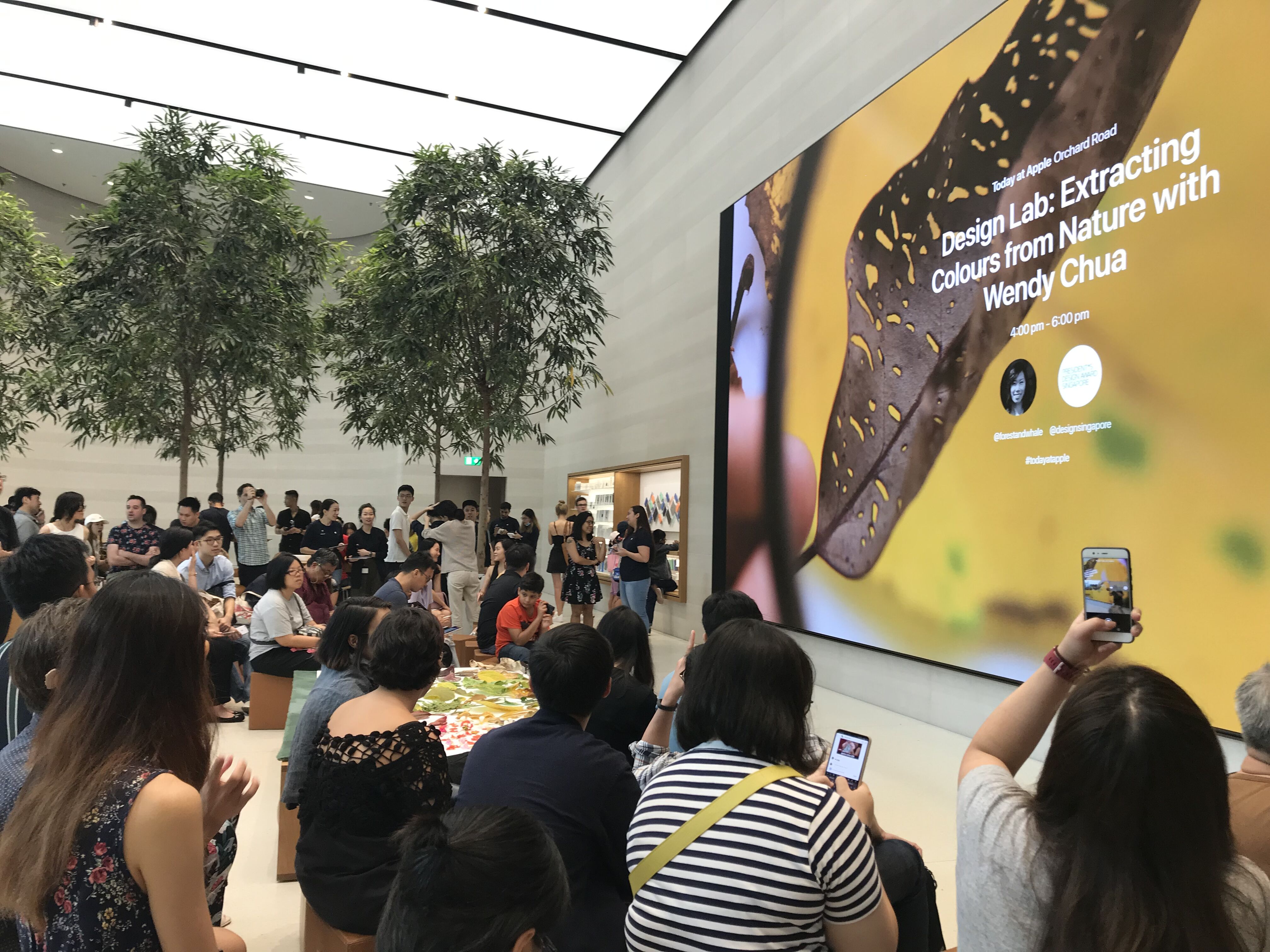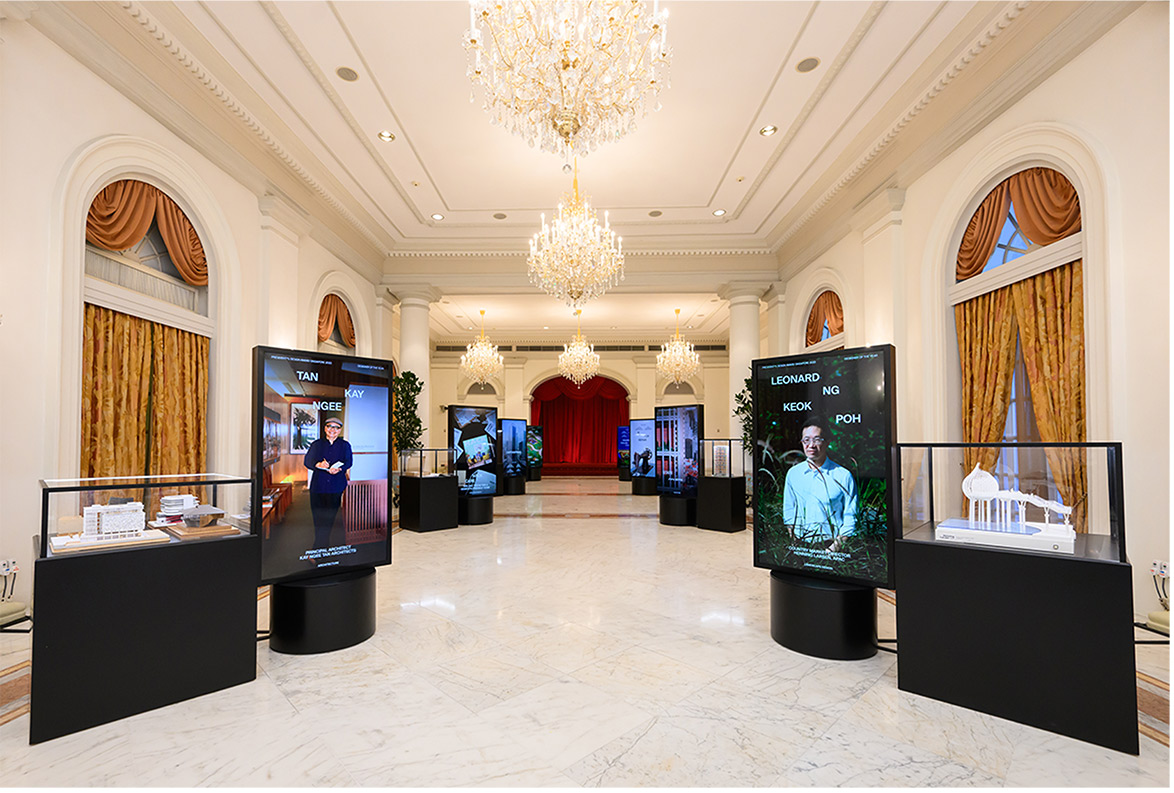P*DA x TODAY AT APPLE: Design Lessons that Take a Leaf from Nature
“President*s Design Award and Today at Apple collaborate to bring you a series of complimentary workshops throughout the year. Conducted by P*DA recipients, these workshops will focus on different areas in design, kicking off with two-time recipient Wendy Chua. Here’s a low-down on Wendy’s session at Apple Orchard Road on 30th March 2019.”

Photo courtesy of Forest & Whale

Photo courtesy of Today at Apple

Photo courtesy of Today at Apple
Bright flowers, flaky tree bark and large leaves. Bits of nature were placed on a knee-high table at the bustling Apple store on Orchard Road. They had been arranged by colour, from the scarlet of the Flame of the Forest blossoms to the dull brown of the Sepetir fruit.
Scavenged from Fort Canning Park, these pieces of flora were the focal point of a workshop by local designer Wendy Chua, a two-time recipient of the President*s Design Award. The session marked the beginning of a series of free learning programmes aimed at inspiring participants to discover new passions and skills.
Wendy kicked off the workshop with a presentation on her practice, which revolves around nature, craft and the exploration of materials. This creative approach ties together her diverse portfolio, which includes the interiors of Plain Vanilla Bakery outlets, museum design and curation for the Red Dot Museum Xiamen and Singapore, a book called The Machinist and more. A co-founder of two design studios, Forest & Whale and Outofstock, her expansive multi-disciplinary portfolio includes both product and spatial design projects for local and international clients. Besides wearing the hat of a designer, she is also a curator, educator and writer.
After Wendy’s presentation, the audience turned their eyes to the table. They were about to learn the design process behind The Tropicals, a rug collection by local company The Rug Maker, and discover how they could extract hues and recreate colours from foraged flora, as well as get hands-on experience with technological tools to frame and capture their own digital compositions.
First, a colour matching process. Workshop participants of various ages, including young children accompanied by parents, gathered around the table, selecting small dyed poms of different coloured hues and placing them next to leaves, flowers, tree bark and seed pods. Several individuals also snapped photos with their mobile phones, intrigued. Others picked up bits of organic matter for a closer look.
Clip-on macro lenses and iPads were subsequently distributed to participants. With the help of these devices, the ordinary flora began to reveal a fascinating world of rich textures and nuanced colours. Lost in these details that were otherwise invisible to the human eye, participants exchanged looks of amazement and captured extreme close-up photographs with the devices.
They then learnt photo-editing skills using the Adobe Lightroom app. Images were cropped. Colour balance and light exposure were adjusted. Filters were applied.
The result: images that sparked imagination.
Reminiscent of alien landscapes, animal skin, abstract paintings, aerial maps and more, the creations of the participants were shared on a wide screen. Individuals also spoke candidly about their experiences. As a participant who brought his family along said, “This workshop brought out the creativity in my kids. They don’t have a camera on a day-to-day basis, so this is really good fun for them!”
Showing a video of the various steps involved in rug-making, Wendy explained how designs for The Tropicals collection were derived from the process participants just went through.
Revealing a beautiful rug, the designer voiced her hope that the workshop has shown everyone how design can still be inspired by the sights, scents and sounds of our natural environments. She encouraged participants to look around them for inspiration in their everyday – even in our local parks!

Photo courtesy of Today at Apple
+++
Q&A with Wendy Chua
How do you think the workshop went?
It went well! It was so diverse. You get people of different ages and backgrounds. There was an illustrator today. She’s deaf, and there was someone doing sign language for her. At the end of the session, she came to me and said this session has inspired her. That’s beautiful.
Much of your work has to do with nature. How did this begin?
The journey personally started in 2012, when I did an apprenticeship with Masayo Ave, a Japanese professor based in Berlin. She pioneered the Haptic Interface Design[1] Institute in Berlin. This work for The Rug Maker is inspired by her.
I am part of Outofstock. Outofstock began out of this amazing friendship that we found when we met in Stockholm as four designers. We were very focused on furniture and spatial design. But I think the more you practise design, the more you need to find meaning in how you want to give back to society.
That was why I wrote the book The Machinist with a team of passionate individuals. Being able to talk about craft, about the embedded knowledge in our hands that is intangible, about people that society forgets but who have so much wisdom… That’s actually another passion of mine.
Slowly over the last five to seven years, I have started to switch towards some of my personal passion projects. They have begun to form my approach, or philosophy so to speak.
In the last four years, I have started another practice called Forest & Whale with my partner Gustavo Maggio, who is also from Outofstock. The reason for this new practice is that we wanted to recalibrate the focus of our work. The work we are doing now is closer to what calls to our inner being. One of that is sensorial design. It’s design that elicits a sensorial experience or to get us to be more in touch with our senses. Partly because of all that digital inundation in our lives.
Today at Apple has been celebrating International Women’s Day throughout March by highlighting the work of female luminaries, yours included. As a successful designer and educator, can you tell us more about the role of women in today’s design landscape?
There are always more females than males in my classes, but in the industry, it’s the reverse. Many female graduates may remain in the creative industry but not take on a creative role.
The industrial design world is quite male-dominated, but things are changing. Take Google. Their hardware division is headed by Ivy Ross. They design high-tech products that some people may traditionally associate with masculinity in form language. Ivy brings a sensitivity to the design language however, especially with the textiles that she has introduced into their recent collection.
The design of the Google Home series required sensitivity with regard to colours and materials, especially when it comes to the nuanced function of artificial intelligence in our homes. I wouldn’t say this is the sole strength of women. I wouldn’t want to pigeonhole us. But I would say it’s good to have a diverse team of designers. If it’s all of one gender, certain critical elements may be missed.
You have received the President*s Design Award Design of the Year in 2010 for Black Forest table, and again in 2015 for the teak furniture collection Prologue. Has that changed your practice?
I think today, we can proudly say we are a notable design capital within Southeast Asia or even, Asia. But ten years ago, we were a very young design nation. So the President*s Design Award (which started 12 years ago) has helped give clients more confidence in the work of designers and has helped to communicate the value of design (in encouraging clients to use designers in their projects). For us, I think the President*s Design Award helped in that clients have more confidence in our work, and there was a lot more trust before they see the final outcome.
What are you working on now?
ustavo and I are creating this collection of objects that draw on ideas that come from experiences like whale-watching. We went to the south of Argentina to watch whales and were very inspired by that.
We are also planning to work on a collection with regards to recycled materials such as aluminium and glass. We are going to visit some factories to see how we can work with these. It’s a bit difficult to do that in Singapore because we don’t have a strong recycling culture, so we are going to places like Taiwan. We really want to create works that use materials that are sustainable.
Any advice for aspiring designers?
Take time out to do self-initiated projects. A lot of times, the reason why we are able to enter new fields, say, to go from furniture to interiors, interiors to museum design, is because our self-initiated projects attracted people whom we would never have met otherwise.
Opportunities come to those who are ready. By working on projects that you are passionate about, you would be able to take on an opportunity when it comes.

Photo courtesy of Today at Apple

Photo courtesy of Today at Apple

Photo courtesy of Today at Apple

Photo courtesy of Today at Apple
+++
[1] Haptic experience design refers to the design of experiences where interactive technology is intentionally related to a user’s sense of touch.
Article written by Ng Hui Hsien.
+++
Watch this space for the next P*DA x Today at Apple workshop, scheduled once a month from March to December 2018. Upcoming workshops will be updated here!









